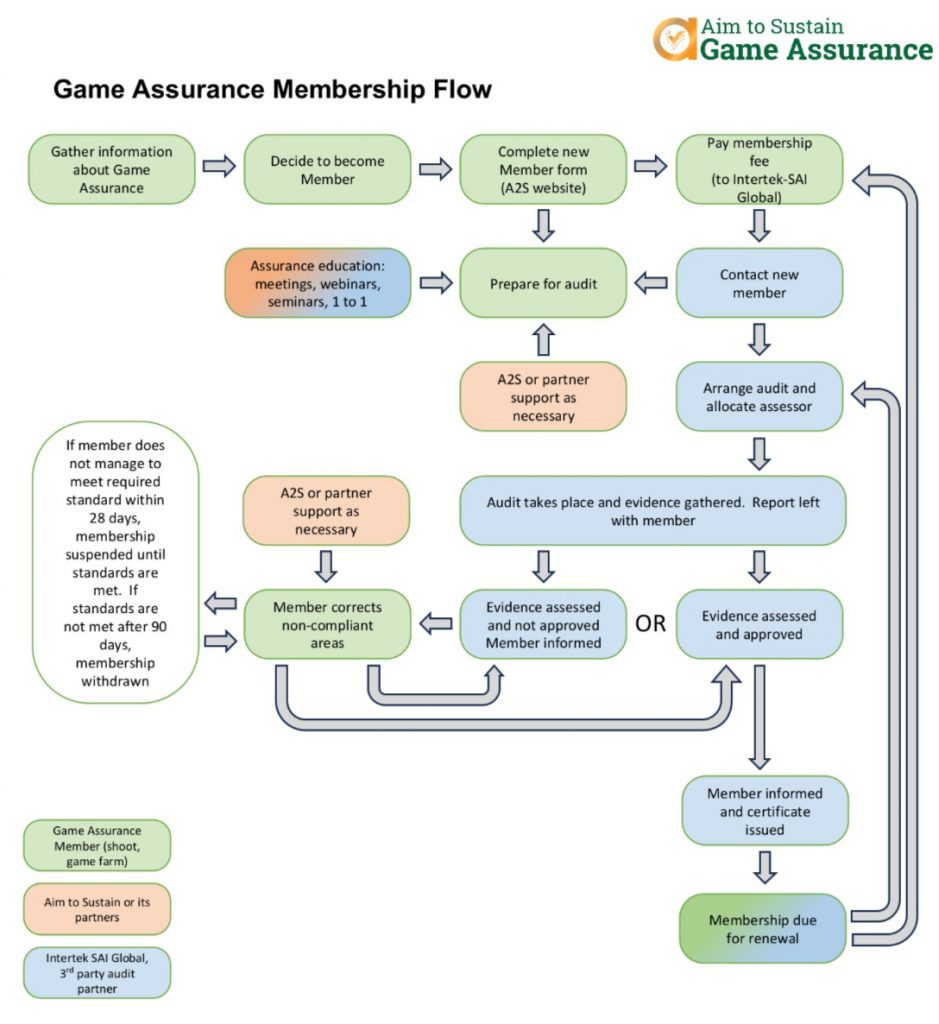Assurance

AIM TO SUSTAIN GAME ASSURANCE:
What is Aim to Sustain Game Assurance?
Aim to Sustain Game Assurance is a voluntary game assurance scheme that provides evidence for game shoots, estates and game farms who are members, that they have been certified to demanding standards. Certified shoots, estates and game farms demonstrate a commitment to self-regulation at a high level by allowing a specialist assurance auditor to come and assess their shoot, estate or game farm.
This audit and certification is carried out by Intertek SAI Global – a world-renowned, highly experienced, and accredited certification body who understand the game management and shooting sector. This gives confidence that game meat from certified members has been produced to the highest standards, from breeding and rearing through release, to the shoot itself.
What are Aim to Sustain Game Assurance Standards?
The standards are based on legislation, science and sector best practice. The standards are varied, comprehensive, auditable, and focus on assessment of animal health and welfare, food quality, environmental enhancement and protection, staff training and health and safety. They are also easy to understand and logical. They cover the things that good operations are already doing and there is support and guidance available to help new and current members prepare for and manage the audit.
The standards have been designed by panels of experts from across the game management and shooting sector and are regularly reviewed to ensure they are rigorous and keep pace with science and best practice developments. The standards are inspected by trained and experienced independent auditors from Intertek-SAI Global.
There are three sets of standards within the Aim to Sustain Game Assurance scheme:
Lowland Shoot Standards:
Upland Shoot Standards (coming soon)
Game Farming Standards (coming soon)
What is the Aim to Sustain Assured Game Logo?
Certified members of the Aim to Sustain Game Assurance scheme can use the logo to demonstrate the high standards to which they operate. It allows game processors and retail outlets selling assured game to show their products have come from certified shoots and estates.
How to become a Certified Member of Aim to Sustain Game Assurance:

Apply for Membership:
All applications are made through Intertek SAI Global. To apply, please complete and return this form to agrifood@saiglobal.com.
The Membership Fees:
Membership fees are paid through Intertek SAI Global. The membership fee covers the cost of the Intertek SAI Global audit and support and guidance to prepare for accreditation from Aim to Sustain partners.
This includes such things as phone or ‘Teams/Zoom’ meetings to provide advice to shoots and game farms, regional seminars and webinars on audit preparation and updates on best practice, relevant scientific research and legislation.
| Lowland Shoot Membership | Annual Membership Fee (ex VAT) |
| 0-3,000 birds shot per season | £380 |
| 3,001 – 10,000 birds shot per season | £625 |
| Greater than 10,001 birds shot per season | £1,250 |
| Upland Shoot Membership | Annual Membership Fee (ex VAT) |
| Under review | Under review |
| Game Farming Membership | Annual Membership Fee (ex VAT) |
| Under review | Under review |
Prepare for the Audit:
Aim to Sustain Partners and Aim to Sustain staff will be able to provide remote support via phone or video conference and in some cases may be able to provide on-site support to assist members and potential members with questions or problems.
There will be live and recorded online webinars providing guidance on particular aspects of the standards, evidence and audit preparation.
There will be an annual programme of regional face-to-face events, meetings stands at rural shows where you can talk about the game assurance scheme. These will be supported by staff from Aim to Sustain, the Partners and Intertek SAI Global.